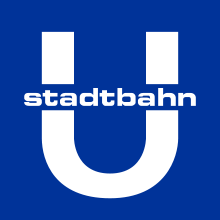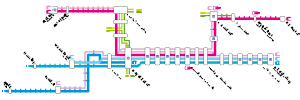Bonn Stadtbahn
 | |
| Overview | |
|---|---|
| Locale |
Bonn and Rhein-Sieg-Kreis, NRW, Germany |
| Transit type | Light rail (Stadtbahn & Straßenbahn) |
| Number of lines | 6 (4 regular + 2 peak lines) |
| Number of stations | 81 (64 in Bonn, 17 in Siegburg/Bad Honnef)[1] |
| Annual ridership | 92 million[1] |
| Website |
www |
| Operation | |
| Began operation | 1975 (as Stadtbahn) |
| Operator(s) | SWB, SSB |
| Number of vehicles | 75 Type B (Stadtbahn)[1] |
| Technical | |
| System length | 95.8 km (59.5 mi)[1] |
| Track gauge |
1,435 mm (4 ft 8 1⁄2 in) (standard gauge) |
The Bonn Stadtbahn (English: city rail) is a part of the local public transit system in Bonn and the surrounding Rhein-Sieg area, that also includes the Bonn Straßenbahn. Although with six actual Stadtbahn lines[1] (as well as three tram lines) the network is relatively small, two of Bonn's Stadtbahn lines connect to the much larger Cologne Stadtbahn (and are numbered according to that system, not Bonn's).
The Stadtbahn network comprises 95.84 kilometres (59.55 mi) of route.[1] There are 64 stations and stops in the city of Bonn proper,[1] and another 17 in Siegburg and Bad Honnef.[1] Additionally, 8.72 kilometres (5.42 mi) of the Stadtbahn is located underground,[1] as are 12 of the Stadtbahn stations.
History
In the middle of the 1960s Bonn lay at the heart of five different railway enterprises. Besides the Deutsche Bundesbahn (the West German national railway company) there was the independent Cologne-Bonn railway (KBE) and three separate tram concerns:
- The tram network operated by the city of Bonn (SWB), which had declined in the 1950s.
- The SSB, which operated electrified services in the Rhein-Sieg area between Bonn, Beuel, Siegburg, and Bad Honnef.
- The BGM, which operated a tram line from Bonn through Bad Godesberg to Mehlem.
This arrangement was inexpedient for a city which boasted 140,000 inhabitants and served as the seat of government for West Germany. The existing arrangement faced competition from the development of automobile traffic, and the federal government was anxious to transform Bonn from a provincial town to a modern capital. At the time trams were considered outmoded and un-modern, so the government was willing to provide funds for removal and replacement.
In 1967 the Bonn City Council approved a new transportation plan which included underground railway (U-Bahn) between Bonn and Bad Godesberg; the initial ground breaking took place in October of the same year. The overall concept involved a mixed system of trams (operated by the SSB) and heavy rail (operated by the KBE). However, the KBE went into financial decline at the end of the decade and survived only with the support of the North Rhine-Westphalia government; in this environment expansion was impossible. Instead, the railway lines of the KBE would be used to provide a link between Bonn and the Cologne tram network. To this end, new, lighter rolling stock was introduced that would be more suitable on Cologne's Rhine bridges and subway tunnels. The Siegburg lines had already switched to Stadtbahn rolling stock in 1974. On 22 March 1975, the Bonn Stadtbahn was officially inaugurated.
Routes


The Bonn Stadtbahn operates over former tram and heavy rail routes, which were either rebuilt for city rail traffic or replaced by underground lines. The only completely new section is the connection over the Südbrücke (South Bridge), which is used by the 66 and 68 on the southbound journey from Bonn Hauptbahnhof to Ramersdorf and Bad Honnef.
Stammstrecke
The "Stammstrecke" (trunk route) is the 4.5 kilometres (2.8 mi) segment between the Bonn Hauptbahnhof station and the Deutsche Telekom stop at United Nations place, which is served by all Stadtbahn lines, but not by the three tram lines. The majority of the route runs through a tunnel constructed in 1975, replacing the BGM-operated tram tracks which ran above-ground along the Adenauerallee and down to Bad Godesberg.
Lines

The Bonn Stadtbahn covers 95.84 kilometres (59.55 mi) of route[1] and is composed of six lines all together, of which four operate regularly and two only during peak hours:
| Line | Route | Notes |
|---|---|---|
| 16 | Köln-Niehl-Sebastianstraße - Köln Hauptbahnhof - Rheinuferbahn - Bonn Hauptbahnhof - Stammstrecke - Bad Godesberg | Operated in cooperation with Cologne Stadtbahn (i.e. is primarily a line of the Cologne Stadtbahn). |
| 18 | Köln-Thielenbruch - Köln Hauptbahnhof - Brühl – Vorgebirgsbahn – Bonn Hauptbahnhof | Operated in cooperation with Cologne Stadtbahn (i.e. is primarily a line of the Cologne Stadtbahn). |
| 63 | Tannenbusch – Rheinuferbahn – Bonn Hauptbahnhof – Stammstrecke – Bad Godesberg | |
| 66 | Siegburg – Siegburg/Bonn – Bonn Hauptbahnhof – Stammstrecke – Südbrücke – Siebengebirgsbahn – Bad Honnef | Nicknamed the "Telekom Express" |
| 67 | Siegburg – Siegburg/Bonn – Bonn Hauptbahnhof – Stammstrecke – Bad Godesberg | Peak line: Weekdays and school days, mornings only |
| 68 | Bornheim – Vorgebirgsbahn – Bonn Hauptbahnhof – Stammstrecke – Südbrücke – Ramersdorf | Peak line: Limited service on weekdays from Bornheim to Ramersdorf; at weekends line terminates at Bonn Hbf |
See also
References
Inline references
Bibliography
- Schwandl, Robert (2012). Schwandl's Tram Atlas Deutschland (in German and English) (3rd ed.). Berlin: Robert Schwandl Verlag. pp. 20–21. ISBN 9783936573336.
External links
| Wikimedia Commons has media related to Bonn Stadtbahn. |
- SWB Bus und Bahn - official site (German)
- Bahnen in Bonn – Historie und neue Ideen (German)
- Fotodokumentation Bonner Haltestellen mit Hintergrundinformationen (German)
- Historical Club SWB – We show history (German) & (English) (Summary only)


